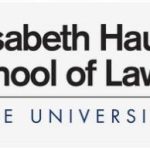Duke University School of Law was founded in 1904 and is the third-oldest law school in North Carolina. It was originally called Trinity College School of Law and located in downtown Durham, North Carolina. The original faculty members included six professors, two lecturers, and seven students. In 1924, the school moved to its current location on the Duke University campus and changed its name to Duke University School of Law. Over the years, Duke Law has grown from a small regional school to one of the most prestigious law schools in the nation. It has consistently been ranked among the top 10 law schools by US News & World Report since 1998. The faculty at Duke Law is composed of renowned scholars who are internationally recognized for their research and teaching excellence. They are experts in various areas such as corporate law, intellectual property law, environmental law, international human rights law, criminal justice reform and more. The curriculum offered at Duke Law is designed to provide students with a comprehensive legal education that prepares them for successful careers as practicing attorneys or legal academics.
Duke University School of Law is located in the state of North Carolina. As one of the leading law programs, Duke University School of Law has a high average LSAT score of 167-171 when recruiting new students. As a return, the median starting salary for law graduates reaches $160,000 per year. See the following table for detailed admissions information and career profiles of Duke University School of Law.
Admissions: Duke University
Duke University School of Law is one of the top-ranked law schools in the country. Its admissions statistics are among the best in the nation. In 2019, Duke Law admitted only 8.5% of applicants, making it an extremely competitive school to get into. The median LSAT score for accepted students was 169, while the median GPA was 3.81. Students admitted to Duke Law come from a variety of backgrounds and hold a wide range of experiences and interests. The student body is highly diverse with more than half identifying as students of color and nearly 20% as international students. Additionally, nearly 40% of enrolled students are female, which is well above national averages for law schools. Duke Law also prides itself on its commitment to public service and pro bono work; more than 85% of its graduates go on to practice law in the public sector or pursue other forms of public service work after graduation.
| Fall 2019 Admissions and Enrollment Statistics | |
|---|---|
| Total number of full- and part-time applicants | 6,334 |
| Total number of full- and part-time acceptances | 1,161 |
| Overall acceptance rate | 18.3% |
| Total number of full- and part-time first-year students enrolled | 228 |
| Number of full-time program applicants | 6,334 |
| Number of full-time program acceptances | 1,161 |
| Full-time acceptance rate | 18.3% |
| Number of first-year full-time students enrolled | 228 |
| Number of part-time program applicants | N/A |
| Number of part-time program acceptances | N/A |
| Part-time acceptance rate | N/A |
| Number of first-year part-time students enrolled | N/A |
| Fall 2019 GPA and LSAT Scores | |
| 25th-75th percentile GPA scores for all students | 3.6-3.84 |
| 25th-75th percentile LSAT scores for all students | 167-171 |
| 25th-75th percentile undergraduate GPA for full-time students | 3.6-3.84 |
| 25th-75th percentile LSAT scores for full-time students | 167-171 |
| 25th-75th percentile undergraduate GPA for part-time students | N/A |
| 25th-75th percentile LSAT scores for part-time students | N/A |
Careers: Duke University
| Bar Statistics (Winter and Summer 2018 administrations) | |
|---|---|
| State where the greatest number of first-time test takers took the bar | NY |
| School’s bar passage rate for first-time test takers | 96.0% |
| Statewide bar passage rate for first-time test takers | 80.7% |
| Class of 2018 Graduates | |
| Total graduates | 207 |
| Graduates employed at graduation | 100.0% |
| Graduates known to be employed nine months after graduation | 100.0% |
| Starting Salaries of 2018 Graduates Employed Full-time | |
| 25th percentile private sector starting salary | $145,000 |
| Median private sector starting salary | $160,000 |
| 75th percentile private sector starting salary | $160,000 |
| Percent in the private sector who reported salary information | 96% |
| Median public service starting salary | $53,500 |
| Areas of Legal Practice (Class of 2018) | |
| Percent employed in academia | 1.0% |
| Percent employed in business and industry | 3.0% |
| Percent employed in government | 2.0% |
| Percent employed in all judicial clerkships | 16.0% |
| Percent employed in law firms | 75.0% |
| Percent employed in public interest | 3.0% |
| Percent employed in an unknown field | 0.0% |
| Percent employed in a judicial clerkship by an Article III federal judge | 13.0% |
| 2018 Graduates Employment Location | |
| Graduates employed in-state | 9% |
| Graduates employed in foreign countries | 0% |
| Number of states where graduates are employed | 30 |
| New England (CT, ME, MA, NH, RI, VT) | 2.0% |
| Middle Atlantic (NY, NJ, PA) | 24.0% |
| East North Central (IL, IN, MI, OH, WI) | 5.0% |
| West North Central (IA, KS, MN, MO, NE, ND, SD) | 1.0% |
| South Atlantic (DE, DC, FL, GA, MD, NC, SC, VA, WV) | 42.0% |
| East South Central (AL, KY, MS, TN) | 3.0% |
| West South Central (AR, LA, OK, TX) | 7.0% |
| Pacific (AK, CA, HI, OR, WA) | 14.0% |
| Mountain (AZ, CO, ID, MT, NV, NM, UT, WY) | 2.0% |
| Employment location unknown | 0.0% |
| Career Services | |
| (Data appear as originally submitted by this school) | |
| Career services operations | Duke students develop life-long skills to pursue fulfilling careers and adapt to a changing world. Graduates work in large and small cities around the country and hundreds of employers interview at Duke. Unlimited counseling and a three-year career development plan help students align personal values and professional aspirations. |
| Job Type | |
| Bar admission required or anticipated (e.g., attorney and corporate counsel positions, law clerks, judicial clerks) | 97.0% |
| J.D. preferred, law degree enhances position (e.g., corporate contracts administrator, alternative dispute resolution specialist, government regulatory analyst, FBI special agent) | 2.0% |
| Professional/other (jobs that require professional skills or training but for which a J.D. is neither preferred nor particularly applicable; e.g., accountant, teacher, business manager, nurse) | 1.0% |
| Nonprofessional/other (job that does not require any professional skills or training or is taken on a temporary basis and not viewed as part of a career path) | 0.0% |








